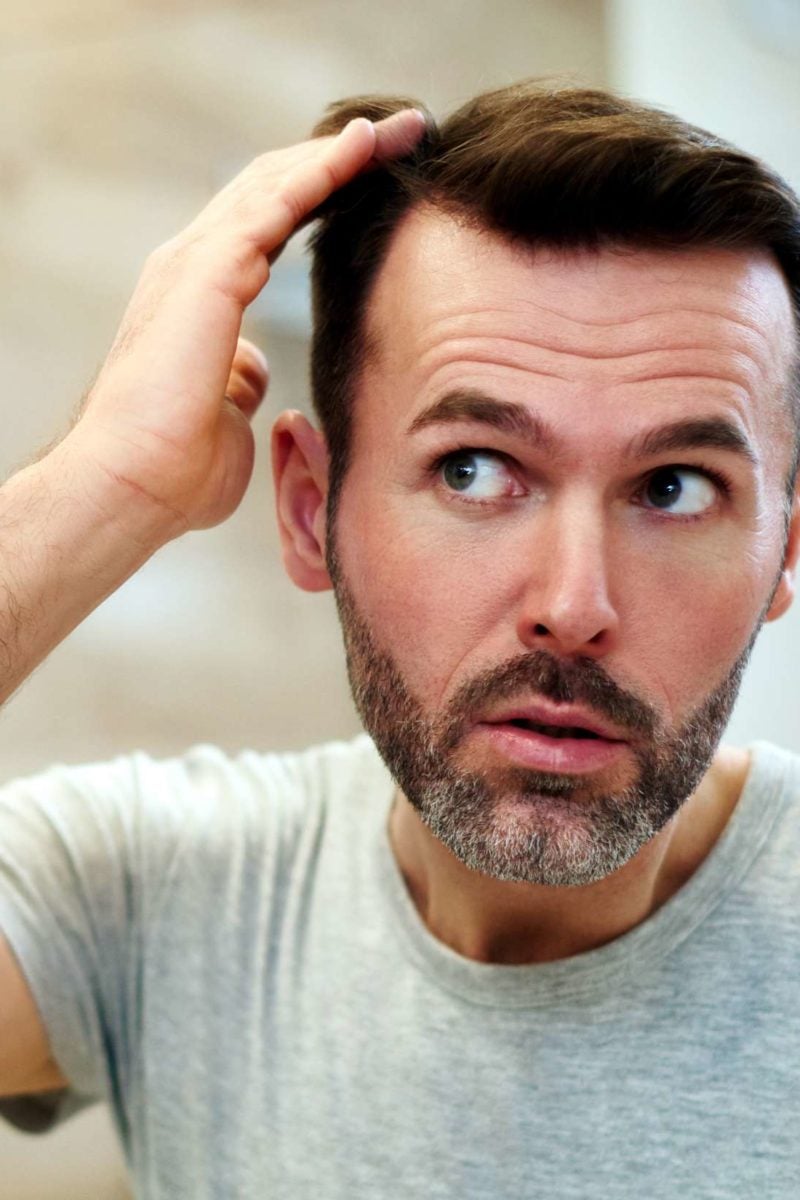How much hair loss is normal?

Medically reviewed by Debra Sullivan, PhD, MSN, RN, CNE, COI
Written by Jon Johnson
A certain amount of hair loss is normal in both males and females. On average, a person loses between 50 and 100 hairs a day.
The hair sheds as part of its natural cycle, which means that seeing hairs in the shower or on a hairbrush is not usually a cause for concern.
A person who notices large chunks of hair falling out or bald spots may wish to see a doctor or dermatologist, however. This excessive shedding may be due to stress or another health issue.
It is important to note that shedding is not the same as permanent hair loss. The hair should return to its previous thickness following the resolution of the underlying cause.
Learn more about how much hair loss is normal in this article.
Number of hairs
Hair falls out every day as part of the body’s natural renewal cycle. The American Academy of Dermatology note that it is normal for a person to lose about 50–100 hairs each day.
Each hair follicle goes through a cycle that includes a growth stage (anagen) and a rest stage (telogen) before the hair falls out. This cycle repeats itself for as long as the hair follicle remains active and continues to produce new hairs.
Most healthy people have between 80,000 and 120,000 hairs on their head. The authors of a 2017 study note that up to 9% of the hair follicles are in the resting stage at any given time, which means that they are ready for the strand to fall out.
People with shorter hair may not notice significant shedding, but those with longer hair tend to see hairs in the shower drain or on hairbrushes and clothing.
People who style their hair may also lose more of it. According to 2018 research, approximately 40% of women experience excessive hair shedding when styling their hair, which includes brushing it.
The authors of a more recent study from 2019 claim that 40% of women experience excessive hair shedding when shampooing their hair.
Chemical dyes, heated curlers and straighteners, and excessive hair brushing can all lead to extra hair shedding or breaks in the hair.
Anyone experiencing a significant change in the amount of hair that they shed may wish to see a doctor or dermatologist to help identify any issues.
Hair falling out while brushing
Many people who style their hair using a hairbrush may worry when they see all the leftover hairs in the brush.
However, brushing the hair generally just removes and collects the hairs that have already fallen from their follicles that day. Although this can be unsettling to see all at once in the hairbrush, it is normal in small amounts.
In some cases, excessive brushing may lead to other issues in the hair, such as breaks. Aggressive brushing may also break or snap the hairs.
Anyone noticing shorter or broken hairs in their brush may wish to talk to a dermatologist about more natural hair care options or ways to strengthen the hair.
Hair falling out while washing
Washing the hair also collects many of the hairs that have already detached from the head.
Some chemical ingredients in shampoos can be harmful and cause breakage or increased hair loss. Anyone who notices an increase in how much hair they wash out in the shower may wish to stop using the product and opt for a gentler formula.
If the increase is sharp, it may be best to see a doctor or dermatologist.
Causes of excessive hair loss
Anyone who is losing more than about 100 hairs a day or noticing large clumps of hair falling out could be experiencing excessive hair shedding.
Hair shedding is not the same as permanent hair loss, which leads to the gradual thinning of the hair or a receding hairline. Shedding hair will regrow in the hair follicle. Hair loss occurs when the follicle stops producing hair.
A short bout of excessive hair shedding can occur due to stressful events or significant changes to the body, such as:
- giving birth
- changing or stopping birth control pills
- losing a lot of weight
- getting over a sickness with a very high fever
- recovering from an illness
- recovering from an operation
- losing a loved one
- going through a significant life change, such as a divorce or job loss
As the body readjusts in the months following a stressful episode, the excessive shedding should stop. Within 6–9 months, the hair should be back to its normal thickness and fullness.
Summary
The average person loses about 50–100 hairs each day, and this number may increase naturally as the person ages.
A stressful event or acute illness may cause a person to shed more hair than normal. In most cases, hair loss returns to its regular rate within a few months.
Anyone who notices that they are losing much more hair than they usually do should see their doctor to help determine the underlying cause.
SOURCE: MEDICAL NEWS TODAY
Comments
Post a Comment